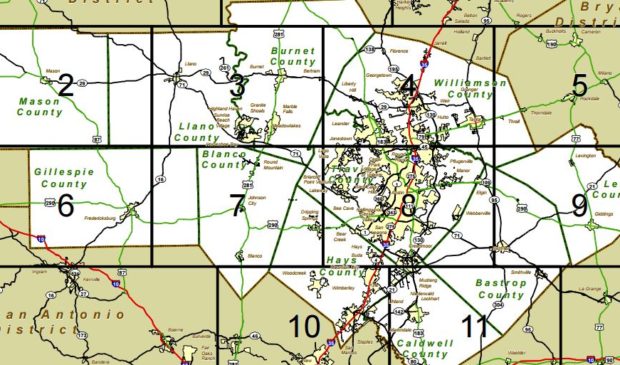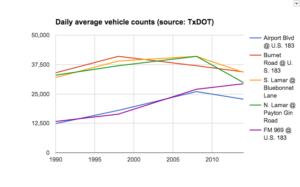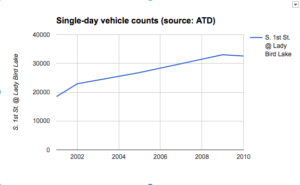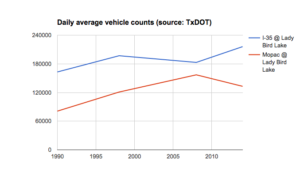Newsletter Signup
The Austin Monitor thanks its sponsors. Become one.
Most Popular Stories
- Latest State of Downtown report shows the city core’s businesses and housing are in transition
- Cap Metro to shelve 46 new electric buses for a year after manufacturer bankruptcy
- Jesús Garza disputes allegation that he violated city ethics rule
- Mobility Committee hears public concern regarding expansion of MoPac
- Council gives first reading OK to major development on tiny slice of land
-
Discover News By District

Updated: Data shows traffic dropping along key corridors
Friday, October 14, 2016 by Caleb Pritchard
Update: Data obtained from the Texas Department of Transportation after this story was published show a dramatic spike in traffic along the North Lamar, South Lamar and Burnet Road corridors – and indeed around much of Austin in general – in 2015. Data show a milder increase in the Airport Boulevard corridor. Overall, vehicle counts along the corridors remained flat from 2010 to 2013. The 2014 data show a decrease in vehicle counts at several key locations. However, the numbers rebounded and then some the following year. Airport Boulevard at U.S. 183 saw 27,000 cars each day in 2015. The daily traffic volume on Burnet at U.S. 183 increased from 34,000 vehicles in 2014 to 44,000 just a year later. The general increase in traffic counts in 2015 made up for a general decline seen in several of the corridors in reports published since 2008. What is behind the sharp uptick remains unclear, but it doesn’t seem that drivers simply found new routes in order to avoid construction on MoPac. In 2015, 25,000 more vehicles crossed Lady Bird Lake each day on that freeway compared to 2014.
Traffic in some of Austin’s busiest corridors is trending downward even as Mayor Steve Adler is trying to convince voters to support his $720 million mobility bond.
That finding comes from data in several Texas Department of Transportation traffic maps obtained by the Austin Monitor.
The four maps provide a snapshot of average annual vehicle counts per day at various points on major Austin roadways from 1990, 1998, 2008 and 2014.
Contrary to popular perception, the data shows that along several of the corridors that would receive the lion’s share of funding from November’s bond program, traffic appears to be on the downswing.

For example, according to TxDOT, there were an average of 26,000 cars per day on Airport Boulevard just north of U.S. Highway 183 in 2008. By 2014, that number had dropped to just under 23,000.
In 1998, Burnet Road just north of U.S. 183 saw 41,000 cars per day. By 2014, TxDOT counted only 34,000.
Daily traffic on South Lamar at Bluebonnet Lane hit a high of 41,000 cars in 2008 before dropping down to 34,000 six years later.
And in 1990, 33,000 cars each day trucked along North Lamar at Payton Gin Road. That count spiked to 41,000 in 2008 before dropping to a 25-year low in 2014 with only 30,000 cars per day.
Mayor Steve Adler’s bond proposal includes $482 million for corridor projects, most of which will fund parts of seven completed or partially completed corridor studies. According to the available data, the only corridor that has seen steady increases in traffic is FM 969. TxDOT’s counts reveal that the roadway just east of U.S. 183 has seen higher volumes of traffic, beginning with 13,300 cars per day in 1990 and increasing to 29,000 cars per day in 2014.
The state agency’s statistics do not include traffic volumes on Guadalupe Street and East Riverside Drive.
While the corridor plans also feature recommendations such as drainage improvements, wider sidewalks, protected bike lanes and provisions for public transit, Adler has recently seized the banner of congestion relief as his battle standard in the campaign to persuade voters to approve his plan. The TxDOT data, however, appears to undermine the argument that runaway traffic is imperiling the quality of life in Austin.
“Well, that’s certainly interesting,” Jim Wick said of the apparent traffic trends on Thursday. Wick is an erstwhile Adler staffer who has taken temporary leave from the mayor’s office in order to direct the pro-bond political action committee Move Austin Forward. “If your hypothesis is that traffic counts are going down and we should expect them to continue to go down, I would say that I don’t know how likely that is, but certainly these corridors are congested.”
He also suggested his own theory for the drop in car counts.
“The stack-ups on the corridors have resulted in essentially higher rates of cut-through traffic through the surrounding neighborhoods along the corridors,” said Wick.
Austin Transportation Department numbers provide conflicting evidence for that theory. The logical neighborhood cut-through street for drivers looking to bypass South Lamar congestion is Kinney Avenue. In 2002, ATD staff counted 3,105 cars in one day in the 900 block of that road. In 2013, the single-day count was down to 3,010 cars.

However, while daily traffic on South Lamar at Lady Bird Lake was lower in 2014 than it was in 1990, ATD’s data shows that, in four one-day snapshots from 2001 to 2010, traffic increased on the nearby South First Street bridge.
At the beginning of the decade, city staff counted 18,500 cars. In 2010, that single-day number jumped to 32,600 cars.
A situation in which more drivers are diverting to more arterials fits the hypothesis floated to the Monitor by Lorraine Atherton, editor of the Zilker Neighborhood Association newsletter, Z-News. In a column in the newsletter’s October issue, Atherton notes that the consultant on the South Lamar corridor study also found declining traffic rates between 2001 and 2013.
“When they’re not detouring other traffic onto South Lamar, the baseline traffic is really steady,” Atherton told the Monitor.
She attributes that to the transformation of Ben White Boulevard into a limited-access freeway in the 1990s. Atherton surmised that the highway has reshaped traffic patterns by funneling cars to Interstate 35 and MoPac Expressway.

TxDOT’s data shows a marked 25-year increase in cars traveling over the lake on both the interstate and MoPac. Each road saw about 52,000 more vehicles per day in 2014 compared to 1990. I-35 saw an all-time average daily high of 216,000 vehicles crossing Lady Bird Lake in 2014. However, MoPac hit its peak of 157,000 cars per day in 2008 before dropping down to 133,000 six years later.
Although Adler’s mobility bond does not include money for any projects aimed at relieving pressure on either of those major roadways, it does include $102 million for expansions along several suburban highways where traffic has increased dramatically, according to TxDOT.
Since 1990, traffic has more than doubled on Loop 360 near Westlake Drive and quadrupled at FM 620 and FM 2222. Parmer Lane north of State Highway 45 now sees 35,500 cars per day, a dramatic increase from its first available count of 24,000 cars in 1998.
However, at 360 near Westlake and on Parmer, traffic ticked down slightly from 2008 to 2014. At 620 and 2222, it dropped from 45,000 cars per day to 42,000.
Wick predicted to the Monitor that opponents would point to the data of stagnant or declining traffic on highways and corridors as reason to reject the bond proposal. He countered, though, that the planned improvements will still help move traffic on the roads faster than at present. He also noted that the corridor plans include projects aimed at making conditions safer for pedestrians and people on bicycles.
“And not only will it address congestion and increase safety and provide more choices, but there are health benefits, there are environmental benefits, there are livability benefits, and quality-of-life benefits,” Wick said. “And it’s part of the overall strategy for what these corridors need to do and be in the future, whether we’re playing catch-up on South Lamar or planning ahead like North Lamar.”
The Austin Monitor’s work is made possible by donations from the community. Though our reporting covers donors from time to time, we are careful to keep business and editorial efforts separate while maintaining transparency. A complete list of donors is available here, and our code of ethics is explained here.
You're a community leader
And we’re honored you look to us for serious, in-depth news. You know a strong community needs local and dedicated watchdog reporting. We’re here for you and that won’t change. Now will you take the powerful next step and support our nonprofit news organization?








